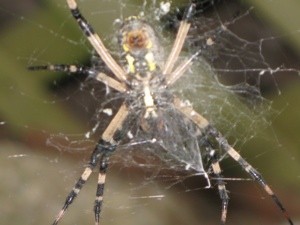 We are very careful not to destroy spider webs. The spider spends day and night catching mosquitoes and other flying insects. We don't have enough mosquitoes to feed many spiders because they have been working hard over the past three or four years. With the bats, spiders, back yard chickens and geese in the water, we find it difficult to even see a mosquito here in the swamps.
We are very careful not to destroy spider webs. The spider spends day and night catching mosquitoes and other flying insects. We don't have enough mosquitoes to feed many spiders because they have been working hard over the past three or four years. With the bats, spiders, back yard chickens and geese in the water, we find it difficult to even see a mosquito here in the swamps.
Source: This spider lives right next to the back door. She is a good neighbor.
By Dr Robert E McGinnis from USA
Here are the questions asked by community members. Read on to see the answers provided by the ThriftyFun community.
Hardiness Zone: 9a
Jaime from USA
I applaud your choice to control pests using natural predators. I admit I'm rather spider-phobic (creepy childhood incident), but enjoy watching them go about their business from a distance. They are truly amazing creatures! Although I'm by no means a spider expert, I was able to unearth this information regarding the average garden spider's life cycle.
Garden spiders lay their eggs within a silken egg sac-usually in the fall. This is the cottony ball or football-shaped sac we often see tucked up inside the spider web, in leaf debris or being carried around by the female spider. Sometimes they lay several of these egg sacs, producing as many as 3,000 eggs over a relatively short period of time. The female usually dies after laying her eggs, and depending on when they were laid, the eggs hatch into spiderlings in a few weeks or wait until the following spring. The spiderlings then make their way out into the world by "ballooning"-producing a single silk thread, which picks them up by the wind and transports them to their new destination. Spiders are considered "adults" in one year and usually only live one or two seasons, although some live for several years. They can shed (molt) their skin up to 12 twelve times before reaching adulthood.
There are generally two classes of spiders-the web spinner and the hunters. Both are extremely beneficial in the garden because of their ability to control pests. They prey on many insects including aphids, caterpillars, cucumber beetles, flies, grasshoppers, leafhoppers, moths and thrips. Web spinning spiders can create their elaborate webs in as fast as an hour, and they are generally more delicate than spiders that hunt on foot. All spiders are very sensitive to lawn and garden chemicals. You can help protect them by leaving some organic mulch overwinter or planting a cover crop for the egg sacs.
Hunting insects, whether by web or on foot, is how spiders make their living. They continue to hunt and capture prey (and control pests in the garden) throughout their short lifetimes. As for the spider webs, leave them up until they feature an expired female spider and/or an empty egg sac.
Ellen
Gardening is an easy task to do. If you see some leaves are blocking out or spotted, the plant may be a victim of sucking insects like aphids or spider mites. Sometimes your plant may also have a bacterial disease and this type of disease spreads quickly, often through improper irrigation where water is busted from an affected plant.